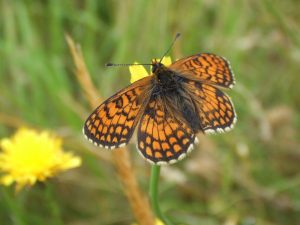Applied Ecology Methods
Below are a selection of applied ecology methods from our research group:
Mapping pollinator natural capital
Pollination underpins >£600 million of British crop production and wild insects provide a substantial contribution to the productivity of many crops. There is mounting evidence that our wild pollinators are struggling and that pollinator populations may be declining. Reliably modelling pollinator populations is important to target conservation efforts and to identify areas at risk of pollination service deficits. We developed the first fully validated pollinator model, capable of reliably predicting pollinator abundance across Great Britain. To learn more see the blog here.
Quantifying changes in the genetic diversity of wild species
We are piloting the world’s first Butterfly Genetics Monitoring Scheme to track the genetic diversity of these insects and understand their resilience to environmental change. Read more about this work here
Quantifying habitat connectivity – how species move through landscapes:
Natural habitats become increasingly fragmented under intensive agricultural land use. Methods to assess the movement of species across landscapes are essential for informing applied conservation to improve species persistence. However previous methods involving capturing-marking-releasing and recapturing species are very time intensive. As a result they can only by carried out on a small scale. Similarly, landscape genetics approaches are expensive. We have developed a non-invasive method which quantifies synchrony in population dynamics from long-term monitoring sites to infer species movement across landscapes. The method has been validated by comparison to landcover data and mark-release-recapture data and is now being used as an experimental indicator by Defra/JNCC
Predicting the resilience of ecosystem functioning:
This method makes use of long-term monitoring data to quantify the extent to which species respond in a similar way to environmental change. In considering how those species deliver function (e.g. pollination, pest control), we can make predictions about how stable an ecosystem function is likely to be in the face of environmental change. Open access paper – Predicting resilience of ecosystem functioning from co‐varying species’ responses to environmental change A recent update exploring the stability of crop pollinating insects and implications for pollination resilience can be found here.
Reconstructing ecological networks from citizen science data:
Understanding how species interact requires intensive field work, necessarily limited to a small area. We have developed a method which makes use of biological records data (records of a species in a particular location and time) in combination with observations of interactions between insects and plant species to produce potential ecological networks for every 10km square in Great Britain. In our example paper we explore how robust these plant-pollinator networks are in the face of agricultural intensification. Open access paper – Potential landscape-scale pollinator networks across Great Britain: structure, stability and influence of agricultural land cover.
Validating ecosystem service models:
There are a huge range of models available to predict the flow of ecosystem services from landscapes (e.g. water quality, pollination, recreational value). However, very few models are appropriately validated which precludes their use in informing real-world landscape management. We have conducted validation of process models for water quality, water yield , and pollination.
Mapping biodiversity:
Despite an excellent history of biological recording in the UK, we still lack good data-driven approaches to map biodiversity. We developed a methodology which uses biological records, accounting for variation in recorder effort, to map biodiversity at 10km resolution over different time periods, for over 4000 species. Open access paper – Developing a biodiversity-based indicator for large-scale environmental assessment: a case study of proposed shale gas extraction sites in Britain.
Developing climate change adaptation plans for species:
General principles of climate change adaptation for biodiversity have been formulated, but do not help prioritize specific actions tailored to species characteristics and local context. We have addressed this need with a decision framework that identifies and prioritizes climate change adaptation actions. The method was cited in the IPCC 4 report – A decision framework for considering climate change adaptation in biodiversity conservation planning, with an application to 30 threatened species – Are existing biodiversity conservation strategies appropriate in a changing climate?.
For more details of other applied ecology methods please see Tom Oliver‘s research publication page
For a research highlight of the impact of our work for butterfly conservation please click the butterfly below

